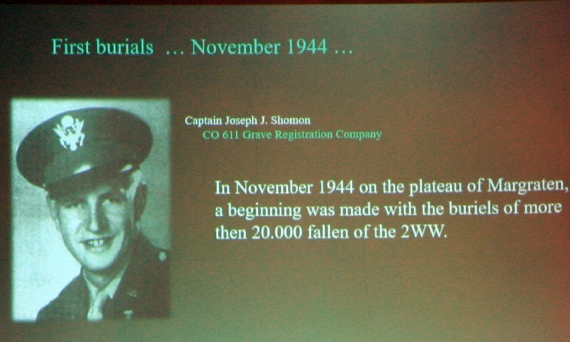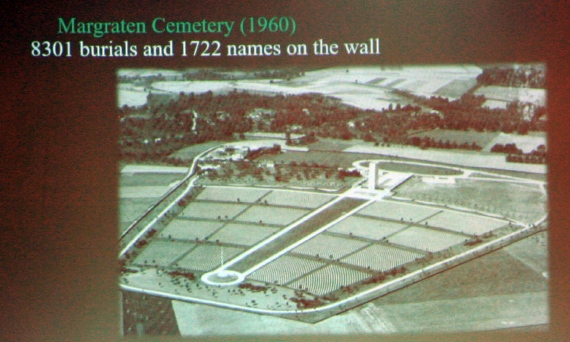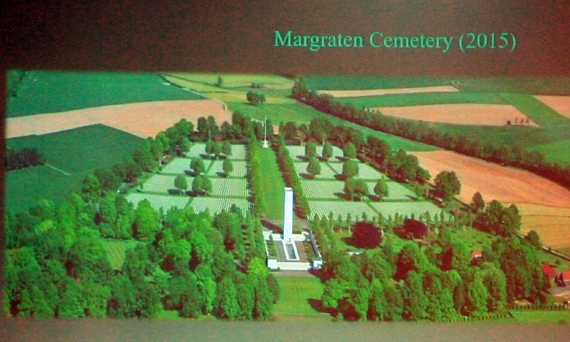Mr. Savelkoul, recounted the campaigns of the US 9th Army during the closing phases of the war, and the promise of its commander, Lieutenant General Simpson, to his men that "No American soldier would remain buried in enemy soil." That imperative resulted in the need for a temporary cemetery, one which was created on farmland, in Margraten, near Maastricht, in the Netherlands. As the 9th Army advanced towards and over the Rhine River, it became necessary to transport the bodies of soldiers killed-in-action back from the front as much as 400 miles, a 3-day trip, to reach the new temporary cemetery at Margraten. To keep the solemn promise made by General Simpson to his soldiers, this was done.

The first burials began in November 1944, under the command of Captain Shoman of the 611th Graves Registration Company. As they were so close to the front lines, almost 20,000 burials eventually became necessary. The cemetery was built on farmland off the road between Maastricht and Aachen, and in rainy, cold weather, making construction very difficult. The native soil, known as "loess" has much clay content, and sticks to a shovel, making the work even more difficult.
Initially, burials were performed by African-American soldiers who, due to existing Army policy, were not permitted to engage in combat action, and who were therefore assigned other duties instead. (It was only later that African-American soldiers and Airmen were allowed to directly fight the enemy.)
With 3 Army Divisions involved in the invasion of Germany and fierce fighting all along the front, trucks often brought over 500 bodies a day to Margraten. The magnitude of the work therefore required Captain Shoman to seek additional labor. Local residents from in and around the area were asked to help, and many volunteered. The general feeling of gratefulness for their liberation motivated their participation.
By 1947, well after the war's conclusion, there were 18,000 graves at Margraten's temporary cemetery. In 1948, construction of the permanent cemetery was begun
and the families of all the interred soldiers were given the choice to repatriate their loved ones remains, or have them permanently buried in the new, permanent cemetery then under construction. Over 10,000 soldiers were thereafter repatriated to the United States, leaving 8301 sets of remains to be reburied in the permanent cemetery, including 8297 men and 4 women. Mr. Savelkoul noted that most soldiers were buried three times: 1st nearby where they fell, 2nd in the temporary cemetery at Margraten and finally either at the permanent cemetery at Margraten, or in their home community, at the family plot or local church or synogogue cemetery.
At Margraten, every final burial was attended by a Dutch priest, often assisted by a US priest, and every soldier's casket flag was returned to the soldiers family in the United States, whenever their identity was known. There are also a number of "unknown soldiers" buried at Margraten, their identities "known but to God."
The permanent cemetery includes a two panel "Wall of the Missing" with 1722 names on it. There is also a separate area where German soldiers are buried, apart from the Americans who had defeated them in battle. Finally, there is a memorial building and tower, with maps of Europe tracing the battles fought nearby, and engraved with inspired words of remembrance. The tower and building were constructed in 1956 and the cemetery opened to the public in 1960.


The Dutch graves adoption program began informally in 1945, when occupation soldiers began to visit the graves of their fellow soldiers who had been killed-in-action. Local priests, volunteering as docents and giving directions to particular graves, were asked by these soldiers to put flowers on their friends graves and take care of them. A town employee, also assisting in this effort, started asking other local people to assist in caring for individual graves, and the "adoption program" was born. These volunteers visited "their" graves on the soldier's birthday and date of death, Memorial Day, July 4th and other significant days and placed flowers upon them. Many eventually tried to contact their soldier's family members in the United States to request a photograph of their soldier, and also developed relationships with these families, commonly sending photographs of the well tended graves back to the United States. A bond was often created between the Dutch and American families.
As time went on, the desire to adopt a grave spread throughout the entire southeastern part of the Netherlands, and within 2 years, all 18,000 original graves were adopted. Thereafter and for 27 years, each adopted grave remained in the care of a single Dutch family. The graves were passed down through generations, often as a part of the last will and testament of its caretaker. The waiting list was so lengthy, that by the early 1970's there was virtually no chance for anyone new to adopt a grave. In 2003 the graves adoption organization that had been formed performed a survey to determine who might want to relinquish the duty of caring for their grave. There were almost 3000 responses returned, but hardly any relinquished their grave for re-adoption.
Ben was finally able to be assigned a soldier in 2006, Sgt. Michael DeFebio. By 2008 the names on the Wall of the Missing were also made available for adoption, and in just two months time all 1722 names were adopted. Occasionally, when a body of a formerly missing soldier is located and reburied, a bronze rosette is placed next to the name on the Wall of the Missing to indicate he was located and identified. This occurs whether the body is repatriated to the United States for reburial, or reburied at another American cemetery in Belgium.
Over the last 10 years, the graves adoption program has expanded to the other countries which have American cemeteries in Europe: to Henri-Chappelle American Cemetery, the Ardennes American Cemetery and Flanders Field American Cemetery, all in Belgium (the latter being a WW1 cemetery) and to the Normandy American Cemetery in France. Ben also cares for the grave of another 643rd soldier, buried at Henri-Chappelle American Cemetery in Belgium, which is also quite close to his home.
At Margraten, as at all the American cemeteries in Europe, there is a formal ceremony each Memorial Day, including bands, children's ensembles and speeches. Margraten also holds the graves of 6 Congressional Medal-of-Honor recipients, including Lt. Colonel Robert C. Cole of the 101st Airborne Division. You can read of Lt. Cole's bravery here: http://www.cmohs.org/recipient-detail/2685/cole-robert-g.php.
Ben's Margraten soldier, Sgt. Michael DeFebio of the 643rd Tank Destroyer Battalion, was killed-in-action on April 12, 1945. Ben's research has led him to Michael's family, which had relocated from Rhode Island to Ohio immediately after the war. Learn more about Sgt DeFebio at Ben's website here: http://www.bensavelkoul.nl/Michael_de_Febio.htm.
In 2010 Ben visited Michael's step-sister, niece and 93-year-old brother-in-law in Ohio. His interest in his soldier, the 643rd TDB and other similar units has expanded now to a near full time hobby, and his several hundred page website detailing his historical research can be explored here: http://www.bensavelkoul.nl/
Ben has also communicated with or met many surviving relatives of the soldiers listed on his website, and in some cases put these relatives in touch with each other. Ben has the email addresses of over 200 family members, and has now accumulated thousands of pictures taken of or by 643rd soldiers. It is a remarkable historical record of a single WW2 unit.
On his trip to Connecticut, Rhode Island and New York over this past week, Ben and Henriette visited Middletown, Connecticut, where a brick house with a bronze plaque stands on Main Street. That plaque denotes the house as the childhood home of General Maurice Rose, who is also buried at Margraten, and whose heroism in battle was legendary among his men. Learn more about General Rose here: https://en.wikipedia.org/wiki/Maurice_Rose and also from this video, here: https://www.youtube.com/watch?v=1Bckk1dN6UE
There have been several books written about Margraten American Cemetery and its soldiers. These include:
1. Crosses in the Wind, by Lt. Col. Joseph Shoman - https://www.amazon.com/Crosses-wind-Joseph-James-Shomon/dp/B0007E9YH4
2. The Margraten Boys, by P. Shrijvers - https://www.amazon.com/Margraten-Boys-European-Americas-Liberators/dp/0230346642
3. Alabama to Margraten, by Jefferson Wiggins - Out of print, but learn more here: https://www.youtube.com/watch?v=QE0QszXRg3k
4.
Farmland to Soldier's Cemetery, by
Mieke Kirkels,
Jo Purnot - https://www.amazon.co.uk/farmland-soldiers-cemetery-eyewitness-construction/dp/908680151X
You can learn all about Ben Savelkoul's research at his main website: http://www.bensavelkoul.nl/
and can contact Ben at: Mail@bensavelkoul.nl
As a fellow Rotarian and member of the editorial team, I would be remiss in not also sharing with you the web page dedicated to my late father, Milton P. Goldman:
http://www.bensavelkoul.nl/Milton_Goldman.htm
I hope you all enjoyed the presentation! - Ed.